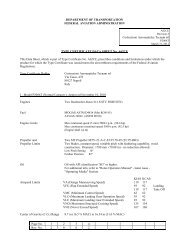P2006T - Tecnam.com
P2006T - Tecnam.com
P2006T - Tecnam.com
You also want an ePaper? Increase the reach of your titles
YUMPU automatically turns print PDFs into web optimized ePapers that Google loves.
Type Certificate Data Sheet № CT319-<strong>P2006T</strong> Issue 07, 27 th March 2014 Page. 5/6<br />
_____________________________________________________________________________________________<br />
16. Airworthiness<br />
limits<br />
17. Required<br />
equipment<br />
Life time limits and other airworthiness limitations are contained in Section B,<br />
Subsection 4: “Airworthiness Limitations” Maintenance Manual, approved by<br />
EASA (AMM Doc. No. 2006/045).<br />
1. In addition to the standard equipment list approved by EASA, the following<br />
equipment must be installed on aircraft:<br />
ADF;<br />
Side-slip indicator (for airplanes with GARMIN G950 EFDS);<br />
Emergency radio operating on 121,5 MHz and located so to be easily<br />
accessible and removable in case of emergency landing. Availability and<br />
installation of emergency radio on board is the responsibility of Operator.<br />
2. All markings and instructions related to emergency equipment, except for<br />
illuminated “EXIT” sign must be written in the language of the State of Operator<br />
and in English language.<br />
18. Noise levels Airplane is approved for <strong>com</strong>pliance with Aviation Regulations, Part 36 (AP-36)<br />
“Aircraft Noise Certification”, Chapter F, Issue 2, and ICAO Annex 16 standards,<br />
Volume 1 “Aviation Noise”, Chapter 10:<br />
Engine Propeller Max. take-off<br />
weight, kg<br />
Rotax 912 S3<br />
Rotax 912 S3<br />
MTV-21-A-C-<br />
F/CF178-05<br />
MTV-21-A-C-<br />
F/CF178-05<br />
Measured<br />
noise level,<br />
dBA<br />
Limit noise<br />
level, dBA<br />
1180 67,07 85,6<br />
1230 72,82 86,2<br />
19. Operational<br />
Limitations<br />
20. Certification<br />
Basis<br />
1. Aircraft is not approved for flights in icing conditions.<br />
2. Day and night IFR and VFR flights are allowed.<br />
3. Cat. I ILS ICAO approaches are allowed in case installation of Fifty Five<br />
X Autopilot is provided.<br />
4. Aircraft operation is allowed at ambient air temperature near the ground<br />
not lower than minus 25°C and not higher than +40°C.<br />
5. Maximum airdrome elevation is 2400 m (8000 ft) pressure altitude.<br />
6. Aircraft can be operated from dry or wet paved airfield, and from<br />
unpaved runway with soil strength not less than 6 kg/cm 2 .<br />
7. Flights over vast water areas are forbidden.<br />
Other limitations are given in the EASA approved AFM, Doc. No.<br />
2006/044 with “Supplement A16 for CIS countries operators” (aircraft<br />
with analog instruments) or in the “Supplement G7 for CIS countries<br />
operators” (aircraft with GARMIN G950 EFDS)<br />
1. Airworthiness Requirements:<br />
Aviation Regulations, Part 23 (AP-23) “Civil light aircraft airworthiness<br />
regulations” through Amendment 4, paragraphs 23.1457 and 25.1459 through<br />
Amendment 5, also Special technical conditions and equivalent safety findings<br />
accepted by EASA and introduced in TCDS of TC № A.185 EASA.<br />
2. Environmental requirements:<br />
Aviation Regulation, Part 36 (AP-36) Chapter F, Issue 2, “Aircraft Noise<br />
Certification” and Annex 16 ICAO, Volume 1 “Aviation Noise”, Chapter 10
















